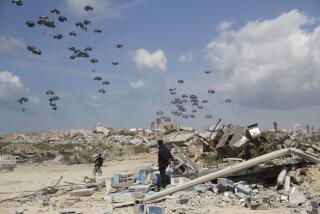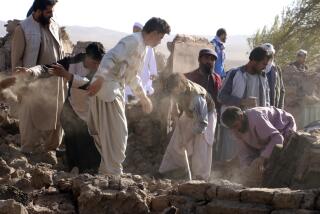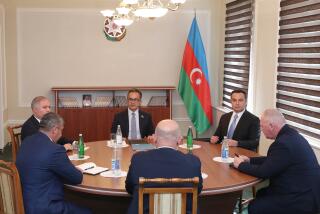Soviet Armored Units Take Up Positions at Major Intersections in Afghan Capital
KABUL, Afghanistan — Soviet armor moved into the center of Kabul on Friday in a strong show of force one day after the start of a unilateral cease-fire declared by the Communist Afghan government.
Western diplomats said they were baffled by the positioning of Soviet tanks and armored personnel carriers at major intersections and near key government buildings.
The diplomats also reported breakdowns in the cease-fire almost as soon as it began early Thursday. They said Soviet and Afghan troops fired at rebel positions near Kandahar in southern Afghanistan and that some shells fell into the market there.
For more than two hours Thursday, the diplomats said, Soviet and Afghan artillery in Kabul fired at targets outside the city.
They described the deployment of Soviet armor in Kabul as one of the largest displays of force since the Afghan leader, Najib, took power last May.
Tanks Rumble Past
More than 15 Soviet armored personnel carriers and at least seven Soviet tanks were seen rumbling through the city. On the outskirts of Kabul, on the Salang highway, a convoy with hundreds of military vehicles was seen. At one point, eight armored personnel carriers roared past the U.S. Embassy.
The Soviet army normally has kept a low profile in Kabul since Soviet troops intervened seven years ago to prop up the Afghan government. An estimated 115,000 Soviet soldiers are now in Afghanistan helping the Afghan army fight Muslim guerrillas.
Kabul television said Friday night that the armored vehicles in the streets were Soviet forces returning to their bases under the cease-fire, but armored vehicles were still at key points in the city as the midnight curfew neared.
Western diplomats speculated that the Soviets were taking precautions against a possible attack by anti-Communist rebels. On the other hand, they said, the use of Soviet rather than Afghan troops in key positions could indicate apprehension over the possibility of a power struggle within the Afghan leadership.
Other Western analysts said there was a similar show of strength on the eve of last week’s visit by Soviet Foreign Minister Eduard A. Shevardnadze. It is possible, these analysts said, that another high-level Soviet visitor is expected.
Shots Miss U.S. Newsmen
In another incident reflecting increased tension, a car carrying four American reporters, including this one, came under fire on the perimeter road near the Kabul airport. At least three shots were heard after the car stopped and two of the reporters stepped out to take photographs. No one was injured, but one bullet apparently hit the ground and ricocheted off the car’s floor panel.
The Soviet government brought in a group of about 50 foreign reporters Wednesday to observe the beginning of the unilaterally declared cease-fire, which is the cornerstone of a “national reconciliation” program that Najib says also will include an amnesty.
As the armored vehicles moved about on the ground Friday, Soviet MI-8 and MI-24 helicopters flew low over the city.
At times Friday, Soviet armored personnel carriers were seen outside the Defense Ministry, the Interior Ministry and the Radio Afghanistan building. Several others, some equipped with light cannons and others with machine guns, were drawn up close to the main Soviet housing complex.
Some of the Soviet vehicles were dusty and mud-spattered, indicating that they had just been brought in from the countryside.
Despite the unexpected show of force, a Western diplomat said that Kabul now is “relatively secure” from attack by the rebel forces, the moujahedeen.
But he said the rebels can still fire rockets into Kabul from the foothills of the snow-capped Paghman Mountains. Last August, dozens of rockets hit areas of the city where Soviet installations are located.
The diplomats said that Soviet and Afghan air operations have been hampered by the more effective anti-aircraft fire that the rebels are now able to put up. Since last fall, the diplomats said, the rebels have been supplied with U.S.-made Stinger missiles.
Soviet and Afghan planes now take more evasive action and drop flares to decoy heat-seeking missiles, they said.
Even so, one of the diplomats said, the overall military situation is an “escalated stalemate,” with both sides suffering greater losses but neither gaining a decisive advantage.
Shultz Urges Withdrawal
In Washington, Secretary of State George P. Shultz said no Afghan solution is possible until the Soviet Union begins to withdraw its troops.
“The essential ingredient is getting those Soviet troops out and doing it in a short period of time,” Shultz told reporters at the State Department.
He said talks among Afghan factions over a new government cannot be held with the Soviet army still in the country, because the troops would “intimidate” the process.
But he said the Reagan Administration remains hopeful that Moscow will offer a timetable for troop withdrawal soon, and said he takes signs of Soviet flexibility seriously.
“There seems to be an awful lot of motion around, and so I think we ought to be ready to respond if there is something to respond to,” he said.
Afghan government officials said that more than 400 guerrilla bands have recently put down their arms and surrendered.
One of the rebel leaders, Mohammed Akram, appeared at a news conference Friday to describe his change of heart. He said that he and his 1,000 followers now guard 32 villages in Herat province in western Afghanistan.
More to Read
Sign up for Essential California
The most important California stories and recommendations in your inbox every morning.
You may occasionally receive promotional content from the Los Angeles Times.










